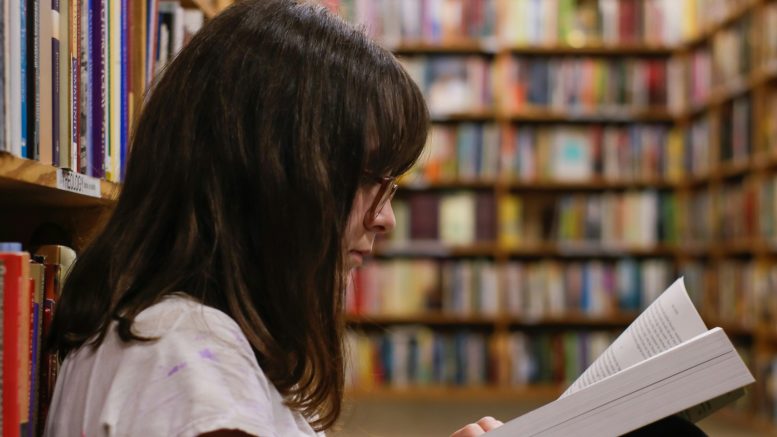By Stephanie Olvido
There are more public libraries in the U.S. than McDonald’s restaurants: 17,278 libraries to about 14,000 stores of the fast food chain. California alone boasts 1,127 libraries, with its capital city hosting 28 branches. Libraries continue to serve up a full menu of accessible information and knowledge.
Yet libraries are changing in the face of digitalization, accelerated by the COVID-19 pandemic. In California, 95% of residents had access to the Internet in 2022, the highest percentage recorded in history. While going digital can create more opportunities, a greater dependence on technology can also widen the gap in opportunities between lower-income and higher-income communities.
Libraries also face steep declines in funding. Gov. Gavin Newsom’s June 2024-2025 budget deal would reduce the California Library Services Act, where public libraries receive state funding, from $4.6 million to approximately $2.9 million. These budget cuts spell trouble for library-adjacent programs, such as the provision of free state park passes from Sacramento libraries, which saw over 6,500 check-outs of these passes in 2023.
Despite the prevalence of libraries, these institutions must adapt to rapid advances in technology and changes in funding to fully serve their communities. Digitization isn’t eliminating librarians’ jobs — it’s just changing how libraries work. Librarians say that with libraries’ accessibility to all and curation of accurate information, these community information hubs are here to stay.
Libraries witness today’s digital divide
Libraries are no strangers to technology. OverDrive, a global e-book and audiobook platform provider for libraries, reported over 662 million digital checkouts from both libraries and schools in 2023, including over 370 million e-books and 235 million audiobooks.
A similar trend is true for Sacramento’s libraries, said Peter Coyl, CEO of the Sacramento Public Library. Half of the library’s checkouts come from digital materials, and people can use their library card to stream movies, according to him.
“There’s a thought that libraries are all about books,” Coyl said. “That’s our bread and butter and mission. But we also do so much more than that.” He added that these checkouts reflect the high demand for digital materials, saying, “We shifted a lot of funding to digitals … to meet that higher demand. And that demand has continued.”
Public libraries also serve citizens in many other ways, including free Wi-Fi, computers, and printers. As the COVID-19 pandemic has changed how work and school look, libraries have become bridges across America’s digital divide between lower-income and higher-income communities.
“Because there’s still a great digital divide in America, there is still a great portion of the country that can’t afford Internet access at their home,” Coyl said. “And they depend on America’s public libraries for Internet access … [and] technology devices to help bridge that gap.”
Libraries of the future
State officials — namely Sen. Angelique Ashby in Sacramento, who authored Senate Bill 321, have worked to adapt the California library system to youth needs. Signed into law last year, it ensures every public school student in California has access to a public library by third grade.
Currently, the Sacramento Public Library provides internet-only library access to over 121,000 students through “student success cards,” or cards issued by local libraries that provide access to library resources. Another provision in the bill would use Sacramento as a model for the rest of California, requiring the State Librarian to ensure that students statewide are issued these cards.
The reason? Third-grade reading proficiency is at 42.1% in 2023, according to the Sacramento Literacy Foundation.
“Essentially, we wanted to connect our public libraries to all third-grade students. Third grade is the time when you stop learning to read and start reading to learn,” explains Michelle Sherwood-Baker, the communications director for Ashby.
The bill is just one example of legislation that not only supports the accessibility of libraries but strengthens them. Despite decreases in funding and usage, libraries have a place in local communities. The outlook isn’t necessarily bleak for librarians, either, with the U.S. Bureau of Labor Statistics reporting a likely 3% increase in the employment of librarians from 2022 to 2032.
Librarians may also find work in smaller libraries, like Sacramento’s Lavender Library, Archives and Cultural Exchange. The library has been serving the LGBTQ+ community through its archives since 1997.
“I think [what] a library will still do [in the future] is provide stuff that just gets lost in the noise online,” volunteer librarian Marin Davidson-Skarstad said. “And we’re also a community space.”
Like many other libraries, the Lavender Library offers free Wi-Fi and printing for those who need it. But its much larger catalog of historical LGBTQ+ periodicals, poetry, and prose isn’t digitized. Still, according to Davidson-Skarstad, the library aims to preserve and celebrate Sacramento’s queer history.
“We have a lot of resources that just don’t exist online because they are so localized,” Davidson-Skarstad said. “They’re so personalized to this community.”
While Newsom’s budget deal has generally reduced public library funding, the act does acknowledge the importance of LGBTQ+ libraries and archives like the Lavender Library.
Section 217 of the act includes $750,000 to “support competitive grants for the preservation and public accessibility of Lesbian, Gay, Bisexual, Transgender, and Queer archives statewide.” At both the local and state levels, libraries have gained recognition as symbols of preservation and history, especially for groups like the LGBTQ+ community.
Libraries, big and small, provide a vast variety of digital and physical materials that serve communities of all forms. In the era of the Internet, physical materials and community spaces will continue to be relevant.
“I think our libraries are here to stay,” Sherwood-Baker said. “I use my library all the time … I think they’re going to continue to help our community stay connected.”
Stephanie Olvido is a reporter with JCal, a collaboration between The Asian American Journalists Association and CalMatters to immerse high school students in California’s news industry.


Be the first to comment on "Libraries staying relevant in a digital world for Sacramento and beyond"